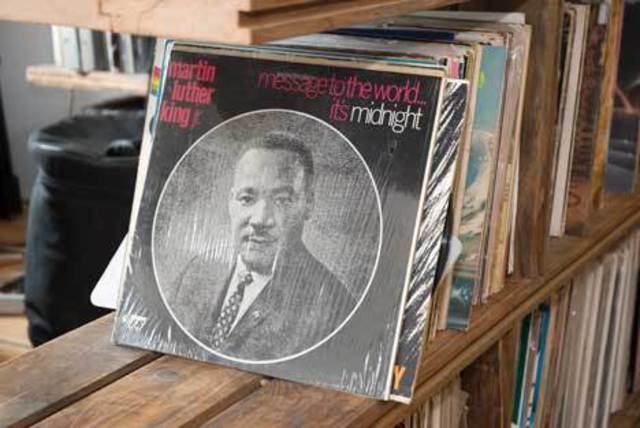Easy Street’s Founder Reviews Theaster Gates’s Record Store as Exhibit

Theaster Gates, a selection from the “Dr. Wax Archive” at Dorchester Projects, Chicago, 2009.
Matt Vaughan’s first instinct is to get his hands on those records. The Easy Street Records founder makes a beeline for the shelf of worn LPs lining the wall of The Listening Room, a new exhibit by Chicago artist Theaster Gates that opened in December at Seattle Art Museum, and starts flipping through the collection. Sly and the Family Stone. Stevie Wonder’s Greatest Hits. Tina Turner. The collection—remnants of Chicago’s now defunct Dr. Wax record store—doubles as a history lesson on music in America, all that blues and jazz and soul from the 1960s through the ’80s. Vaughan is in search of gems when a museum guard rushes over to stop him. No touching! Though apparently people touch this exhibit all the time.
“Yeah, they should change that policy,” Vaughan says.
It certainly contradicts the vibe in this corner of the museum, where funk is pumped in through speakers. The rest of the layout is as minimalist as a shack: a few rustic chairs and a couple of wooden crates housing records (that you can actually touch) litter the floor, and old fire hoses line the walls—“civil tapestries” from Birmingham, Alabama, in the 1960s, when the fire department was asked to restrain civil rights demonstrators. “What is the relationship between music and the political?” asks Gates, a visual artist/activist, in his exhibit introduction. “Where are safe spaces and cultural spaces of Seattle?”
Despite a handslap from a museum guard, this space does feel welcoming; it encourages chatter, and in this case, a chance for a record store owner to appraise the goods. “For everything? About $200,” Vaughan says within four minutes of being in the room. “A lot of these are represses or were budget releases when they came out.”
Then there’s the artistic value in these vinyl relics that goes beyond any sticker price. “This 12-by-12-inch square is almost like a 12-by-12 canvas,” he says. “You’re not going to see someone painting on a 5-by-5 frame, like a CD, very often. It’s clear what the cover art is saying to you at this size, but if it was shrunk down it really wouldn’t hold the same way or speak to you the same way.”
To make his point, Vaughan rummages through the crates and picks out a copy of Stevie Wonder’s Innervisions, which features a sepia-toned painting of Wonder against a mountain backdrop. “Here’s a perfect example of a great album art. As an album, it’s telling you to come inside.” He opens the album gatefold. “It’s got the lyrics readily available; it’s right there. It’s not like you’re opening up liner notes or having to get on the Internet to pull up lyrics. It’s all one piece. It’s all one gift.”
With The Listening Room, Gates wants the viewer to explore the social and political history that can be found in a dead record shop. And while Vaughn thinks Seattle might be the wrong city to host such an exhibit because of its abundance of thriving record stores, the exhibit’s irony isn’t lost on him.
“It’s funny because people often say record stores are turning into museums, and here you’ve brought the record store into the museum. I hope Easy Street doesn’t wind up here one day.”
Theaster Gates: The Listening Room
Thru July 1, Seattle Art Museum Downtown




